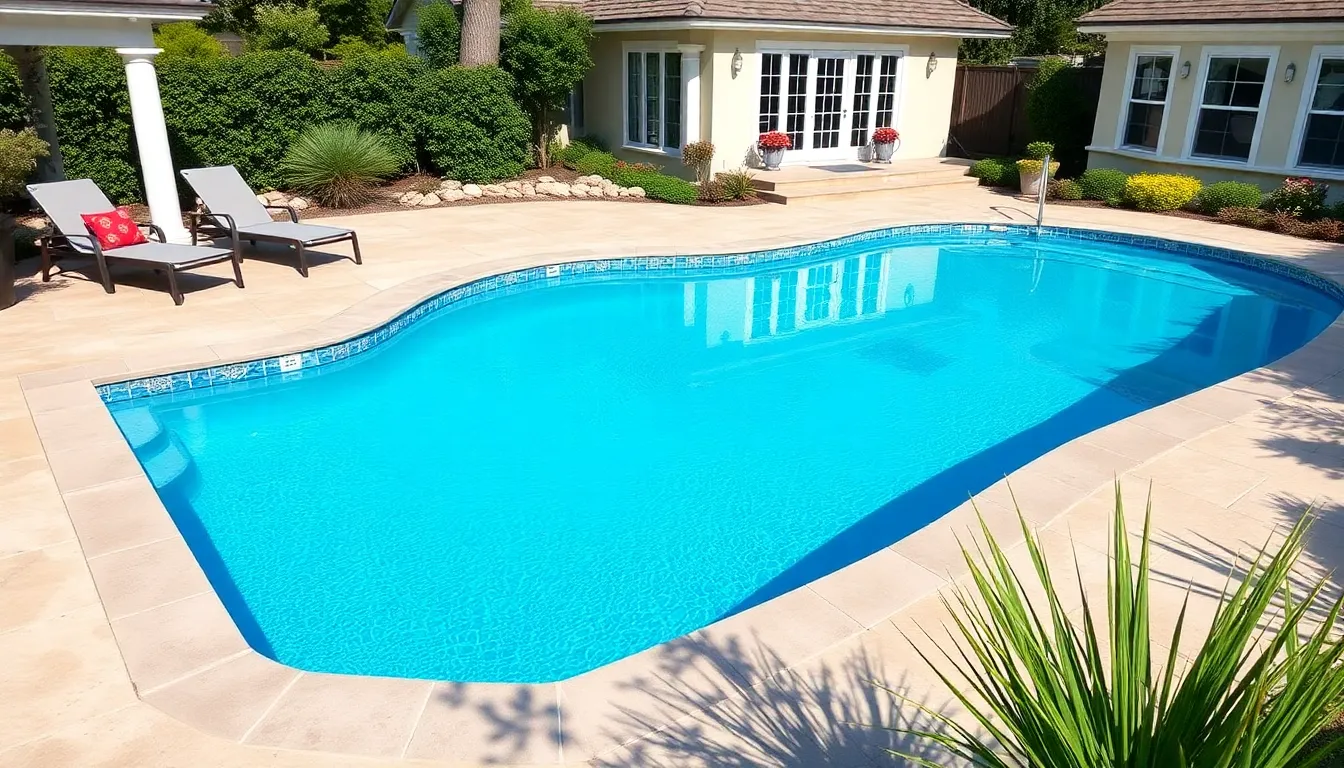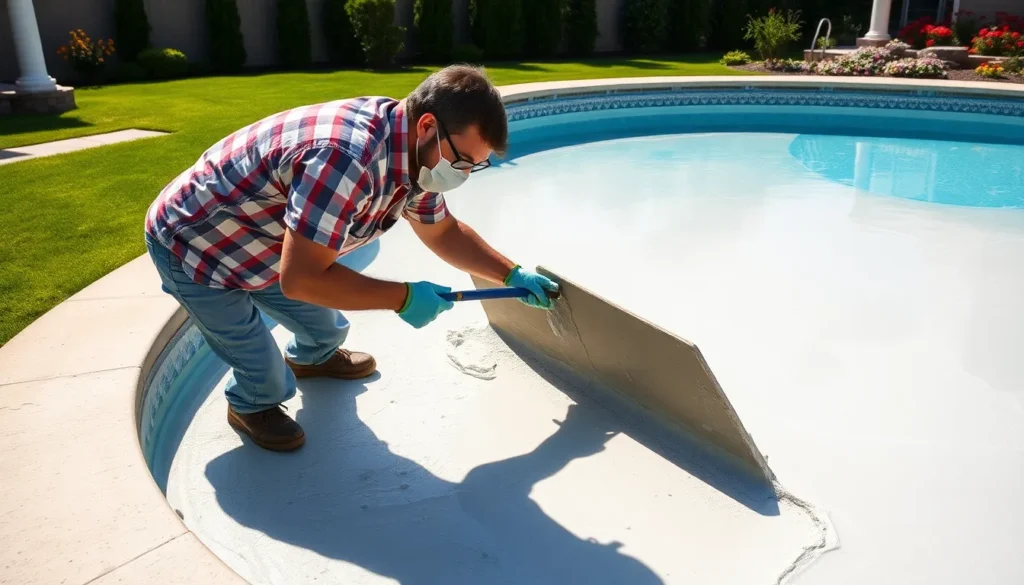Table of Contents
ToggleWhen life gives you a dull pool, it’s time to dive into the world of pool resurfacing. Just like a fresh coat of paint can transform a drab room into a stunning space, resurfacing can breathe new life into that tired, cracked pool. It’s not just about aesthetics; it’s about safety, longevity, and making your backyard the envy of the neighborhood.
What Is Pool Resurfacing?
Pool resurfacing refers to the process of applying a new layer of material to the interior surface of a swimming pool. This procedure addresses wear and tear caused by time, chemicals, and environmental factors. Over time, pools can develop cracks, stains, and rough patches, affecting both their aesthetics and safety.
Multiple materials, including plaster, pebble, and fiberglass, serve as options for resurfacing. Plaster provides a smooth finish and is often more affordable. Pebble surfaces offer a unique look and enhanced durability. Fiberglass, while typically more expensive, adds longevity and requires minimal maintenance.
Resurfacing restores the pool’s appearance while also preventing leaks and structural damage. It enhances safety by eliminating sharp edges and slippery patches that can lead to injuries. Additionally, this process makes the pool environment more hygienic by reducing the likelihood of algae growth.
Routine inspections highlight the need for resurfacing, with many experts suggesting every 5 to 10 years depending on usage and material quality. Homeowners should consult with professionals to evaluate the condition of their pools regularly. Timely intervention can help avoid costly repairs down the line.
Ultimately, pool resurfacing represents an investment in both the appearance and safety of a swimming pool. It transforms a neglected space into an inviting centerpiece for outdoor entertainment and family enjoyment.
Benefits Of Pool Resurfacing

Pool resurfacing offers significant advantages for both aesthetics and functionality. Homeowners recognize that it revitalizes their outdoor space, enhancing both appearance and safety.
Enhanced Aesthetics
A freshly resurfaced pool transforms an uninviting space into a visual centerpiece. Fresh surfaces eliminate unsightly stains, cracks, and discoloration. Various materials like plaster, pebble, and fiberglass each provide unique finishes, contributing to different visual styles. Homeowners can create a luxurious look that complements their outdoor decor. Color choices can add vibrancy or subtle elegance, depending on personal preference. A well-resurfaced pool invites guests and enhances property value through improved curb appeal.
Improved Safety
Safety remains a top priority for pool owners. Resurfacing addresses rough edges and slippery areas that pose risks. A smooth, uniform surface reduces the chances of slips and falls, especially for children and elderly users. Eliminating cracks prevents tripping hazards, creating a safer swimming environment. Additionally, professional resurfacing involves a thorough inspection, ensuring integrity and preventing further damage. A safe pool not only protects users but also provides peace of mind for homeowners, encouraging enjoyable swimming experiences for all.
Increased Durability
Durability is a key advantage of pool resurfacing. Fresh layers can withstand wear from chemicals and environmental factors, ensuring longevity. Resurfacing also prevents water leaks that could lead to extensive damage over time. High-quality materials can enhance resilience to cracking and fading, reducing the frequency of future repairs. Regular maintenance further extends longevity, contributing to the pool’s overall lifespan. Homeowners investing in resurfacing recognize it as a proactive measure, rather than a temporary fix.
Types Of Pool Resurfacing Materials
Various materials exist for pool resurfacing, each offering unique benefits.
Plaster
Plaster is a cost-effective and traditional choice for pool resurfacing. It provides a smooth and clean finish that enhances the pool’s appearance. This material typically lasts 5 to 10 years before requiring replacement. While plaster is durable, it may develop stains or rough spots over time. It also allows for easy customization with dyes to achieve desired colors. Regular maintenance, including acid washing, keeps its surface looking fresh and appealing.
Pebble Finishes
Pebble finishes include small stones embedded in a cement base, creating an aesthetically pleasing texture. These surfaces are more durable than plaster and resist stains, leading to a longer lifespan of 10 to 20 years. The rough texture helps improve grip, enhancing safety for swimmers. Many homeowners prefer pebbles for their natural look and versatility in design. It’s easier to maintain algae growth due to fewer crevices than plaster.
Vinyl Liner
Vinyl liners provide a soft and smooth surface, appealing for many homeowners. Customizable in various patterns and colors, vinyl adds a unique touch to the pool’s design. This type of resurfacing can last 10 to 15 years with proper care. Although less durable, it offers an affordable option for maintaining pools. Replacing a vinyl liner is quick and simple, minimizing downtime.
Tile
Tile resurfacing offers a stylish and durable option for pool owners. Various materials, including ceramic and glass, provide versatility in design and color. Tile surfaces last over 20 years, making them a long-term investment for any pool. The smooth finish minimizes algae growth, promoting a healthier swimming environment. Repairing individual tiles is easy, allowing for quick fixes without requiring a full resurfacing. A wide range of patterns allows homeowners to create unique looks that enhance outdoor aesthetics.
The Pool Resurfacing Process
The pool resurfacing process involves several critical steps for achieving optimal results. Each phase ensures a thorough and effective transformation of the pool’s surface.
Preparing The Pool Surface
Preparing the pool surface sets the foundation for successful resurfacing. It starts with draining the water and thoroughly cleaning the pool to remove debris and contaminants. Inspecting the surface for cracks and rough spots occurs next, as these require filling or smoothing. Removing old materials, like plaster or tile, may also be necessary to enhance adhesion for the new layer. Accomplished professionals will take precise measurements during this stage to ensure the new surface fits perfectly.
Application Techniques
Application techniques vary based on the chosen resurfacing material. For plaster, professionals typically spray or trowel the material onto the prepared surface to achieve an even coating. When using pebble finishes, a special mix is spread and packed down to form a durable textural layer. Vinyl liners involve precise cutting and placement against walls and floors, ensuring a snug fit. Tile application requires careful installation with adhesive and grout, making attention to detail essential for a polished look.
Drying And Curing
After application, the drying and curing phase ensures the longevity of the new surface. Curing times depend on the material; plaster may need several days, while pebble surfaces often require at least one week to fully set. Maintaining proper humidity and temperature during this phase helps prevent cracking. It’s vital to monitor conditions, as environmental factors play a role in the curing process. Professionals typically recommend waiting to fill the pool for the specified duration to maximize durability.
Investing in pool resurfacing is a smart choice for any homeowner looking to enhance their outdoor space. By addressing wear and tear while improving safety and aesthetics, resurfacing transforms a pool into a beautiful and functional centerpiece. With various materials available each offering unique benefits, homeowners can tailor their choice to meet both budget and style preferences. Regular maintenance and timely resurfacing can prevent costly repairs down the line, ensuring the pool remains a safe and inviting retreat for years to come. Embracing this process not only elevates the pool’s appeal but also contributes to a more enjoyable swimming experience.




